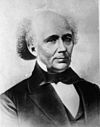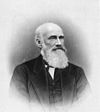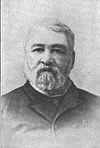Utah Territory's at-large congressional district
Appearance
Utah Territory's At-large congressional district is an obsolete congressional district that encompassed the area of the Utah Territory. After Utah's admission to the Union as the 45th state by act of Congress on January 4, 1896, this district was dissolved and replaced by Utah's At-large congressional district.
List of delegates
On September 9, 1850, an act of Congress gave Utah Territory the authority to elect a congressional delegate,[1] though the first delegate did not take his seat until 1851. The territorial delegates were elected to two-year terms. Delegates were allowed to serve on committees, debate, and submit legislation, but were not permitted to vote on bills.[2]
Democratic (D) Independent (Ind.) Populist (Pop.) Republican (R)
Notes
- ^ George Q. Cannon won the election, but the governor appointed Allen G. Campbell. Cannon successfully contested the election, but the House decided not to seat Cannon on grounds that Cannon was a polygamist.[3][4]
- ^ Elected to fill the vacancy created when the House refused to seat George Q. Cannon[5]
References
- General
- "Biographical Directory of the United States Congress 1774–2005". Biographical Directory of the United States Congress. Clerk of the United States House of Representatives and Historian of the United States Senate. Retrieved January 29, 2011.
- "Members of Congress: Utah". Infoplease. Pearson Education. Retrieved January 29, 2011.
- Specific
- ^ "ch. 51, §13, 9 Stat. 457". 31st United States Congress. Library of Congress. Retrieved January 29, 2010.
- ^ "Delegates to the U.S. Congress: History and Current Status" (PDF). Congressional Research Service. Retrieved January 17, 2011.
- ^ "How the Plot Was Spoiled". Deseret News. Salt Lake City. July 6, 1881. Retrieved May 4, 2010.
- ^ "The Polygamous Delegate". Lewiston Evening Journal. April 20, 1882. Retrieved May 4, 2010.
- ^ "Favorable Report on the Utah Delegate". Deseret News. Salt Lake City. December 21, 1882. Retrieved May 4, 2010.







